When the speed is not the same ...
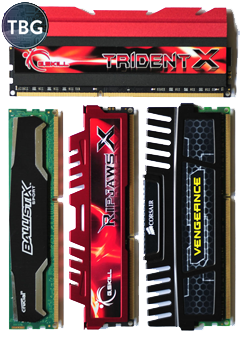
This article is a free and abbreviated translation of the article “Does RAM Speed Matter? DDR3-1600 vs 1866, 2133 and 2400 in Games ”, published on one site about a year ago and updated in the middle of the year 2015. Also, she, the article, can serve as a kind of answer to the latest publications on both GT and HabraHabr itself dedicated to the new line of RAM-memory ( 1 , 2 and 3 ) and Moore's law in data storage .
So, the preamble is quite simple: on the old new (from the point of view of Intel - outdated chipset) computer after 3 years of service, RAM (Corsair Vengeance DDR3-1600) began to fail, throwing Win10 on a blue screen of death with MEMORY_MANAGEMENT error in a completely random order. I thought that it would be nice to hand over the old memory and buy a new one, respectively, the question arose: what to choose? And the great and omnipotent Google led me to the above article, a brief summary of which I will now share with some examples.
Spoiler for always hurrying
Yes, my dear friend, there is no tangible difference between DDR3-1600 and other types of DDR.
This is all a conspiracy of the damned marketers!
This is all a conspiracy of the damned marketers!
The shortest presentation of the article
The guys wanted to test the most common lines of RAM in the same price category:
- Crucial Ballistix Sport 2x4GB DDR3-1600 (9-9-9-24, 1.5V) - $ 75
- Patriot Viper III 2x4GB DDR3-1866 (9-10-9-27, 1.5V) - $ 87
- Corsair Vengeance 2x4GB DDR3-2133 (11-11-11-27, 1.5V) - $ 93
- Corsair Vengeance Pro 2x4GB DDR3-2400 (11-13-13-31, 1.65V) - $ 93
- G.Skill TridentX 2x4GB DDR3-2400 (10-12-12-31, 1.65V) - $ 93
However, laziness took her. The testers' promise was that, in principle, all memory is manufactured according to the same standards, so there is no fundamental difference whether to test all of them or take the top one and kill its parameters. Actually this is the only trick that the authors did. The top-end G.Skill TridentX memory was chosen and its characteristics were already underestimated in order to match the necessary parameters of the rest. The most important characteristics of RAM are the timings : CAS latency (CL) , RAS to CAS delay (tRCD), RAS precharge (tRP), and cycle time (tRAS), that is, all those 4 digits written on the packages and listed above. And one more setting was made on the command rate (CMD), the value of which was set to 1T, instead of 2T.
')
It is important to remember and understand that if we are talking about overclocking and some maximum settings, then, perhaps, there is no need for special tools. But let's ask you extremely honestly: Who in today's world needs overclocking, when everything works out of the box extremely quickly? For example, for me, the era of overclocking is over 10 years ago, when overclocking really added fps at least in hard games.
But back to our
Motherboard: ASRock Z97 Extreme4
Processor: Intel Core i7-4770K (overclocked to 4.5GHz)
Video card: MSI GeForce GTX 780 Ti Gaming 3GB (GeForce Driver 344.65)
SSD: Crucial MX100 512GB
CPU cooling: Corsair Hydro H100i
Body: Corsair Carbide 500R
Power Source: EVGA Supernova G2 850W
OS: Windows 8.1
The list of tested games includes both modern and relatively “ancient” games and applications:
- 3dmark
- Grid 2
- Metro: Last Light
- Thief
- Crysis 3
- Battlefield 4
Well, the first one went. 3DMark.
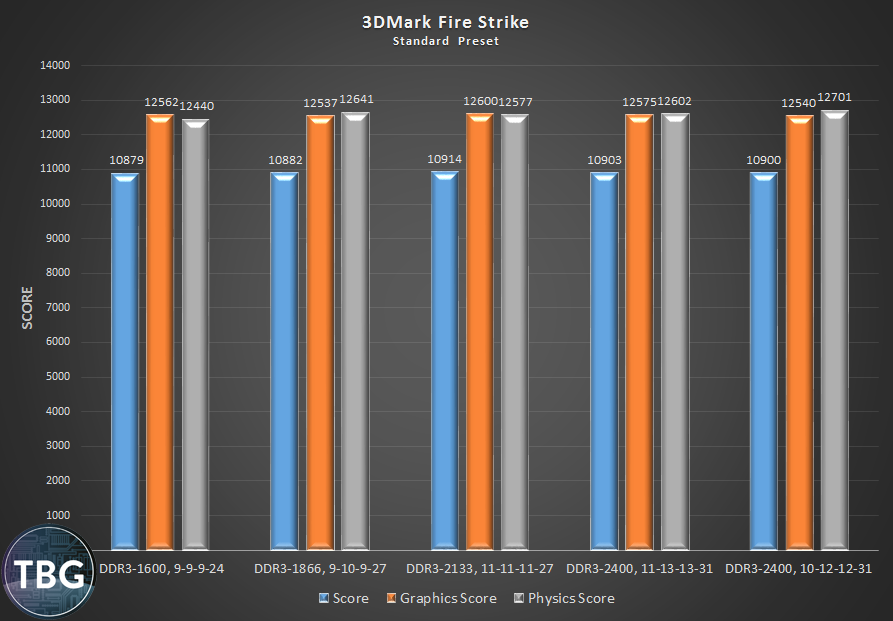
Many gamers will argue that 3DMark is a measurement of a spherical horse in a vacuum by parrots, but this is only partly true. For example, points for graphics (Graphics Score) for all tested configurations were identical. But the points for physics (Physics Score) are slightly different between configurations, but the difference is so small that the authors simply do not consider it significant - 2.1% between the best and the worst.
We will not litter the air by testing all the games, we will give only a couple of screenshots for comparison, such as Metro and Battlefield 4.
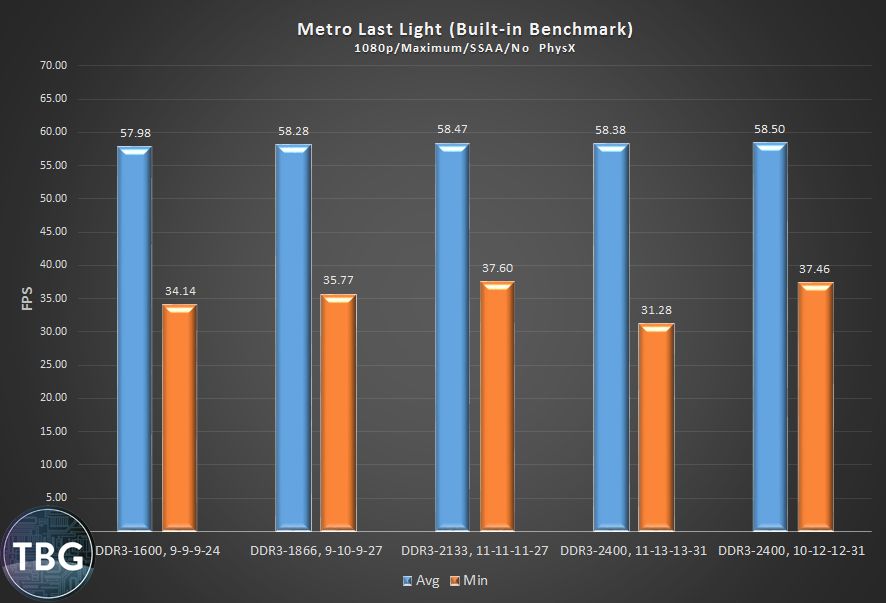
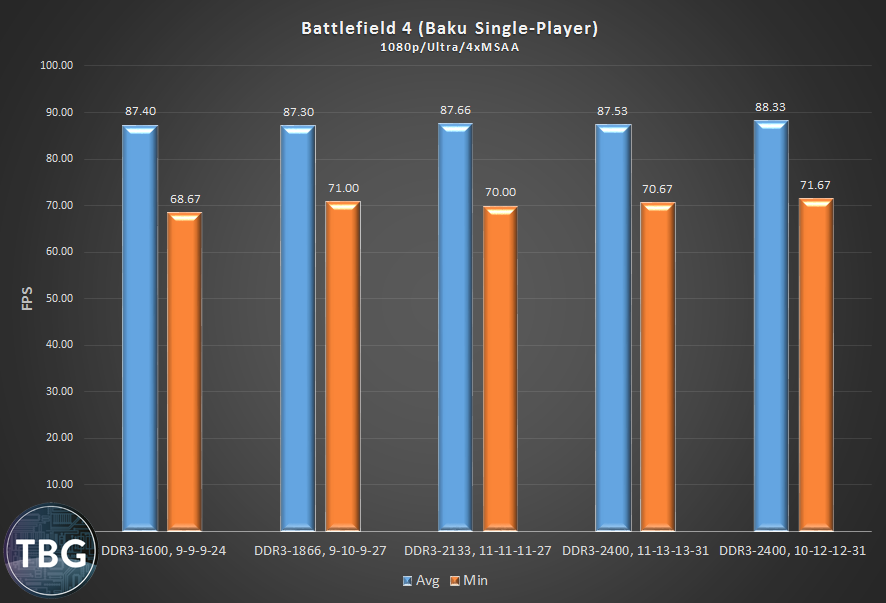
Surprised ?!
I myself was slightly amazed and even puzzled, because once upon a time it seemed that the more frequencies, volumes and speeds, the better. And here it turns out that modern games no longer need RAM per se, a maximum of RAM and CPU bundles, and more and more GPU and GDDR.
And lastly, a little comparison. The average hospital temperature obtained for all tested games (yes, MHz in the header is an error and should be read 4.5 GHz):
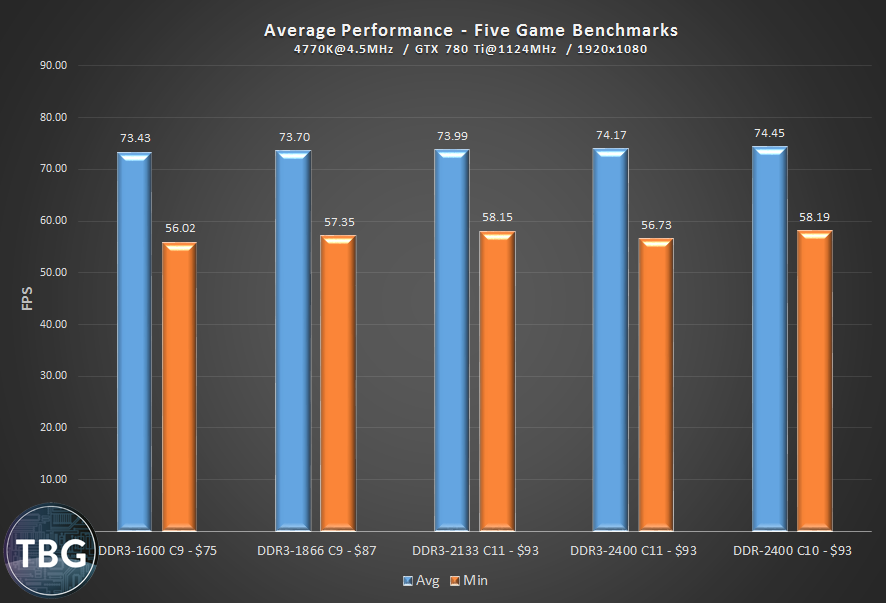
If you count the number of frames per dollar spent, it turns out that DDR3-1866 can become one of the most advantageous offers at the moment, but still worth remembering that memory with a frequency above 1600 MHz simply does not give a significant performance increase. Actually, this is one of the main conclusions of the authors. If you have an extra pair of bucks for a cooler memory - feel free to buy memory with increased frequency, but you should not get involved in and chase MHz for the sake of MHz.
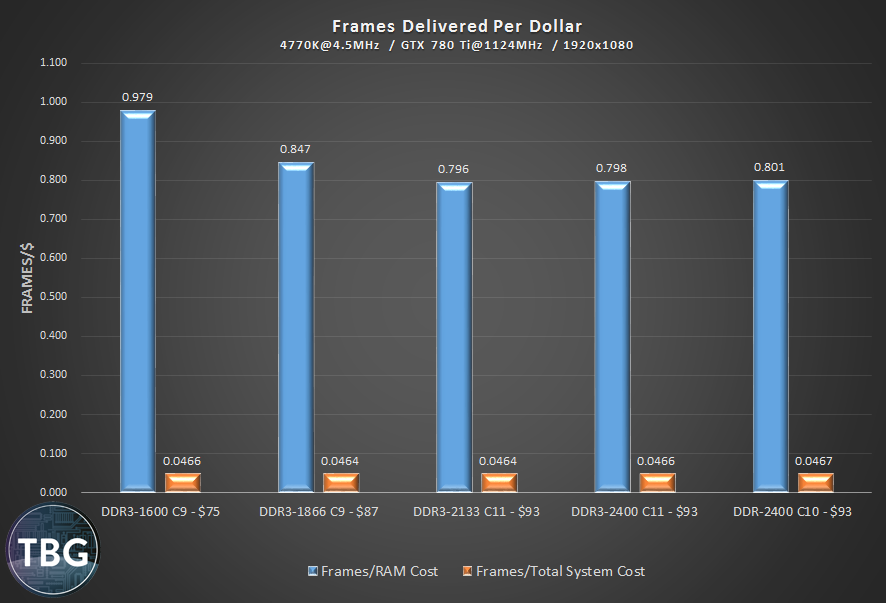
Comparison of the cost of fps for a dollar spent and the cost of RAM in the price of the system unit
Yes, it is also worth noting that back in 2013, the team was distinguished by studying the effect of memory on the gameplay : even the system with 4 GB on board did a good job with various tests.
Instead of conclusion
Why a summary of this article posted on the GT? I would like users to rely more on objective characteristics, rather than reassurances from marketers and new-fangled technologies (such as DDR3L and DDR4), if you cannot determine why you need one or another exaggerated characteristic. More, more powerful, stronger, faster - this is not always an indicator of progress. Similar comparisons can be made for processors, video cards, SSD drives, where surprisingly it turns out that mid-range solutions are the very optimum that the user and / or gamer need.
And a question for manufacturers: why should they be led by marketers in order to produce the same product every year under a different sauce, preferably not compatible with previous versions (like Intel does, for example, stamping more and more new chipsets), instead of to come to grips with the development of something truly new and breakthrough, such as MRAM and futuristic carbon microelectronics ?!
PS: As a result, I exchanged Corsair Vengeance for the first thing that was in the store, similar in volume and characteristics, the same Fury DDR3-1600.
Sometimes briefly, and sometimes not so much about the news of science and technology, you can read on my Telegram channel - welcome;)
Source: https://habr.com/ru/post/367247/
All Articles